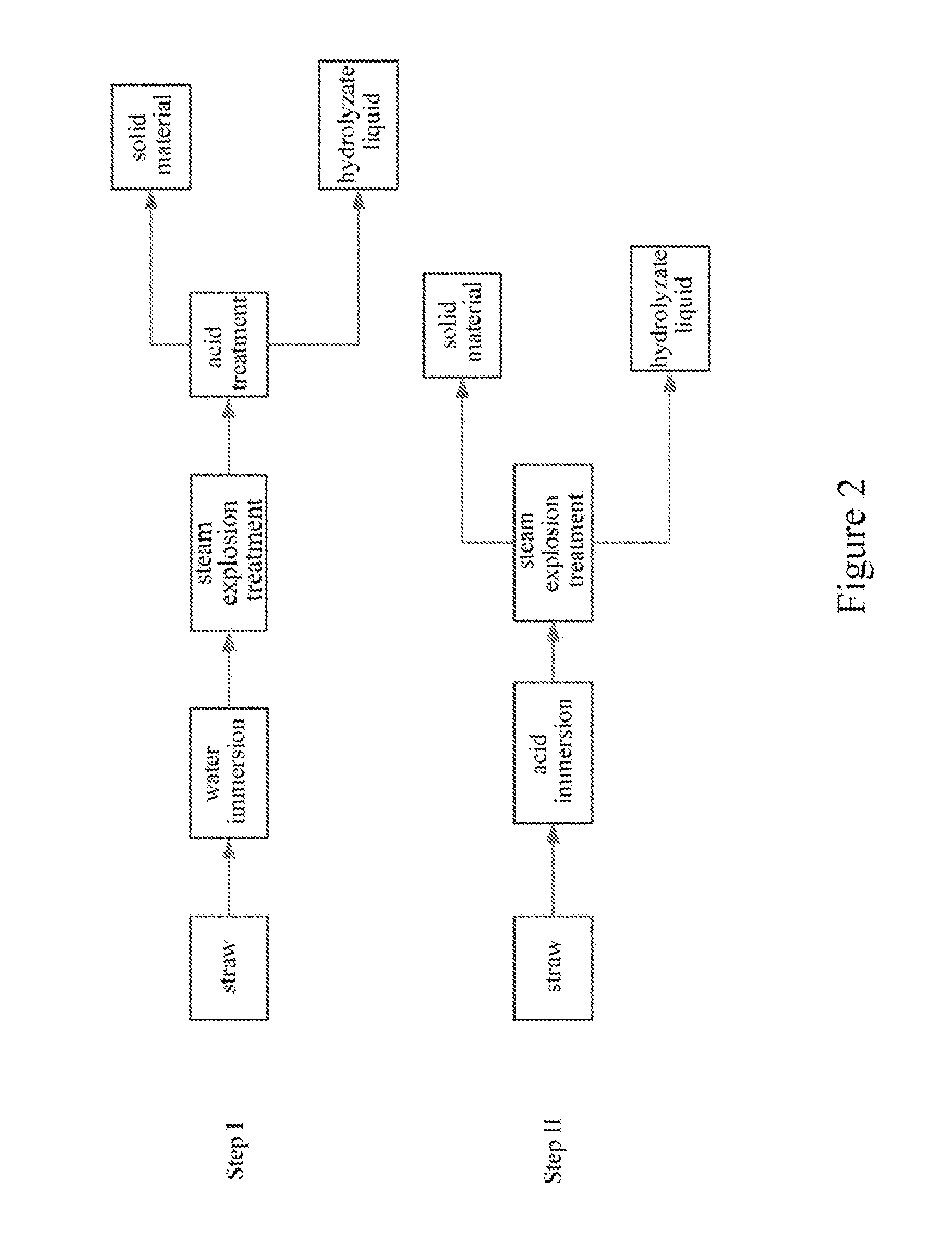Process for producing bio-based product from straw hemicellulose and fully utilizing the components thereof
a technology of straw hemicellulose and bio-based products, which is applied in the field of comprehensive can solve the problems that biofuels from food supplies cannot meet the needs of the community, corn and soybeans cannot be used to produce biofuels, and endanger food safety, etc., and achieves high-value utilization of straw resources, high cost, and high cost
- Summary
- Abstract
- Description
- Claims
- Application Information
AI Technical Summary
Benefits of technology
Problems solved by technology
Method used
Image
Examples
example 1
[0059]One ton of air-dried corn straw (its water content is less than 5 wt %) was cut into 5-10 cm pieces by a cutting machine. Water at 15° C. was added to the straw pieces, and the straw pieces were soaked in the water for 60 min, wherein the mass ratio of straw to water was 1:1. Then the wet straw material was fed into a steam-explosion tank in a size of 11 m3, and processed at a pressure of 0.3 MPa for 10 mins to generate a steam-exploded wet straw material. The steam-exploded wet straw material was then fed into an acid-hydrolysis tank in a size of 80 m3, and hydrolyzed with 0.8 wt % sulfuric acid, wherein the mass ratio of the steam-exploded straw to the acid was 1:2, the hydrolysis temperature was 75° C. The reaction was performed for 60 mins. Then, the steam-exploded straw and hydrolyzate liquid from the hydrolysis tank were fed into a plate filter to separate and obtain a steam-exploded straw hydrolyzate liquid and a steam-exploded straw solid material. The contents of cell...
example 2
[0060]This Example was carried out in a substantially same manner as in Example 1, except that the straw was soaked in water at 50° C. for 30 mins; the mass ratio of straw to water was 1:2; the processing conditions for the steam explosion included a 0.8 Mpa pressure for 5 minutes; acid treatment conditions included a 30 mins reaction between 1.2 wt % of sulfuric acid and the steam-exploded straw at 90° C., wherein the mass ratio of the steam-exploded straw to the acid was 1:5.
[0061]The steam-exploded straw and hydrolyzate liquid from the hydrolysis tank were fed into a plate filter to separate and obtain a steam-exploded straw hydrolyzate liquid and a steam-exploded straw solid material. The contents of cellulose, hemicellulose and lignin in the steam-exploded straw solid material were measured. Compared with the chemical composition of the original straw, the degradation rate of the hemicellulose in the steam-exploded and acid-treated straw reached 82% (see Table 1).
example 3
[0062]This Example was carried out in a substantially same manner as in Example 1, except that the straw was soaked in water at 90° C. for 10 mins; the mass ratio of straw to water was 1:3; the processing conditions for the steam explosion included a 2 Mpa pressure for 1 minutes; acid treatment conditions included a 10 mins reaction between 1.6 wt % of sulfuric acid and the steam-exploded straw at 105° C., wherein the mass ratio of the steam-exploded straw to the acid was 1:7.
[0063]The steam-exploded straw and hydrolyzate liquid from the hydrolysis tank were fed into a plate filter to separate and obtain a steam-exploded straw hydrolyzate liquid and a steam-exploded straw solid material. The contents of cellulose, hemicellulose and lignin in the steam-exploded straw solid material were measured. Compared with the chemical composition of the original straw, the degradation rate of the hemicellulose in the steam-exploded and acid-treated straw reached 90% (see Table 1).
PUM
| Property | Measurement | Unit |
|---|---|---|
| Temperature | aaaaa | aaaaa |
| Temperature | aaaaa | aaaaa |
| Temperature | aaaaa | aaaaa |
Abstract
Description
Claims
Application Information
 Login to View More
Login to View More - R&D
- Intellectual Property
- Life Sciences
- Materials
- Tech Scout
- Unparalleled Data Quality
- Higher Quality Content
- 60% Fewer Hallucinations
Browse by: Latest US Patents, China's latest patents, Technical Efficacy Thesaurus, Application Domain, Technology Topic, Popular Technical Reports.
© 2025 PatSnap. All rights reserved.Legal|Privacy policy|Modern Slavery Act Transparency Statement|Sitemap|About US| Contact US: help@patsnap.com


